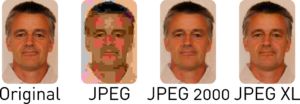Sebastian Schachner successfully defended his Bachelor Thesis on „Auswirkung von Kompression auf die Bildqualität für Gesichtserkennung“

This work compares different compression schemes with respect to face recognition. Face recognition is an essential part of today’s society, as digital identification of people is becoming more common, for example with digital ID cards. For this purpose, a reference image is stored on the device, which is compressed to be stored in a space-saving manner. For this different types of compression are available. In order to achieve the smallest possible storage sizes, lossy compression types are used.
For the compression the schemes Joint Photographic Experts Group (JPEG), JPEG 2000 and JPEG XL are chosen, as well as the downscaling of images in the Portable Network Graphics (PNG) scheme. In addition, an autoencoder approach is used that uses an 128 dimensional embedding and compressed residual images. The residual images are created from the difference of a blurred image, generated by decoding the embedding, and the original image. Two experiments were conducted for the analysis. The first experiment uses images cropped to relevant face informations in regards to face recognition. The second experiment uses portrait images. Both experiments are analyzed for image quality and comparability using different target sizes. For the Face Image Quality Assessment (FIQA), five models based on Deep Convolutional Neural Network (DCNN)s and two models estimating the sharpness of the images are used. For image comparisons the ArcFace model is used. Mated image pairs, non mated image pairs and original images mated with compressed images are compared. In addition, we analyse the deviations of the actual sizes of the compressed images to the target sizes and to what extent the quality assessment match the mated comparison values.
In general it could be shown that JPEG XL could achieve the best quality preservation and the best comparison values. Furthermore, it could be shown that JPEG XL achieved the target values best. However, it was shown that quality assessment models do not always correlate with the comparison values. Therefore, it could be concluded that the influence of compression for face recognition depends on the target size and the compression type. Thus, for strong compression, the smallest influence could be observed for JPEG XL and for scaled PNG images the largest influence on face recognition was measured. However, at low compression the approaches were largely similar. This work can be used as a basis for further research. On the one hand, this work can be used to further improve the estimation of image quality models, and on the other hand, it can be used as a basis to develop better compression methods, especially for compression regarding face recognition.
